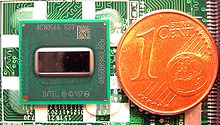But today, Intel have a problem. ARM designed processors don’t try to be faster than high-end Intel chips, but they are much cheaper, and consume a lot less power than Intel’s designs have ever needed to before, something becoming crucial in the world of smart phones, tablets, and massive data centers.
Intel have refocused, producing a new generation of Atom chips code named Valleyview, out in early 2014, designed to fight back against these ARM chips in the areas of power usage, performance, and price.
The problem for Intel is that the companies using these new ARM chips don’t buy the completed chips from ARM, they just licence a design, and can build the entire chip themselves, or buy it from a number of different suppliers. For the largest of manufacturers, like Samsung and Apple, this means chips made exactly how they want them, to their own specifications, all built in their own dedicated factories or through suppliers which operate on extremely low profit margins.
For example, the new Google Nexus 10 tablet is built by Samsung, and consists of almost entirely Samsung built components, including the ARM designed processor, the memory, and the storage, giving them the ability to bring costs down to previously unheard of levels.
So how do Intel compete against this? The last thing Intel want is to start selling what used to be a $100 Intel manufactured processor and chipset for $20, but perhaps if they were willing to licence the newest Atom designs to Samsung and Apple, they could cut ARM out of some of the profitable suppliers they’ve picked up recently, and regain the initiative in low powered processor designs.
This would be a big step for Intel, but if there’s one thing I’m sure of, it’s that the status quo can not remain for long, Intel either have to change, because the world is changing around them.
